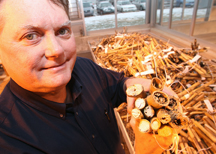

December 17, 2008
Researchers find nature's shut-off switch for cellulose production
WEST LAFAYETTE, Ind. - |
Nicholas Carpita, a professor of botany and plant pathology, said that small-interfering RNAs (siRNAs) play a normal role in plant development by shutting off genes involved in primary cell wall growth in order to begin development of thicker, secondary cell walls.
"These small RNAs were known to play a role in fending off disease-causing pathogens, but we are only now beginning to understand their involvement in normal plant development," he said.
Carpita's research team reported its findings in Monday's (Dec. 15) early online issue of the Proceedings of the National Academy of Sciences.
"If we can learn to interfere with the down-regulation of cellulose synthesis, then plants may be able to produce more cellulose, which is key to biofuels production," Carpita said.
Mick Held, a postdoctoral researcher in Carpita's lab, virologist Steve Scofield, a U.S. Department of Agriculture research scientist and adjunct assistant professor of agronomy at Purdue, and Carpita made the discovery in barley after introducing a virus as a way to "silence" specific genes and study their functions. The researchers noticed that the virus had more effect then anticipated.
"The virus hijacked a whole suite of genes, and when we compared the targeted plant to our control plants we found that the small RNAs were responsible and already in the controls even without adding the virus," Held said.
Carpita said this let researchers see that the siRNAs - among other things - regulate and shut down primary cell wall development to begin secondary wall growth.
"These secondary stages result in characteristics such as tough rinds of corn stalks, vascular elements to conduct water and fibers for strength," he said.
The researchers said that delaying or preventing the shutdown of both primary and secondary cellulose production might enhance total plant biomass.
"Most biofuel researchers believe that cellulose utilization offers the best path to sustainable ethanol production," Scofield said. "Our work uncovered a previously unknown mechanism that suggests a way to increase the amount of cellulose produced in plants."
Other members of the research team were Bryan Penning and Sarah Kessans of Purdue and Amanda Brandt of the USDA/Ag Research Service, Crop Production and Pest Control Research Unit located at Purdue.
The research was funded by a U.S. Department of Energy, Energy Biosciences grant.
Writer: Beth Forbes, (765) 494-2722, forbes@purdue.edu
Source: Nicholas Carpita, (765) 494-4653, carpita@purdue.edu
Mick Held, heldm@msu.edu
Steve Scofield, Office: (765) 494-3674; Lab: (765) 496-2232, scofield@purdue.edu
Ag Communications: (765) 494-2722;
Beth Forbes, forbes@purdue.edu
Agriculture News Page
Note to Journalists: A copy of the research paper is available at https://www.pnas.org/cgi/doi/10.1073/pnas.0809408105 or by contacting the PNAS news office at (202) 334-1310, PNASNews@nas.edu
PHOTO CAPTION:
Purdue researcher Nick Carpita said plants may be able to produce more biofuel mass if the means of shutting down cellulose production is disrupted. His research team learned that small RNAs are key in determining the duration of cellulose production. (Purdue Agricultural Communication photo/Tom Campbell)
A publication-quality photo is available at https://www.purdue.edu/uns/images/+2008/biofuel-corn-stalks.jpg
Small-interfering RNAs from Natural Antisense Transcripts Derived from a Cellulose Synthase Gene Modulate Cell Wall Biosynthesis in Barley
Michael A. Held, Bryan Penning, Amanda S. Brandt,
Sarah A. Kessans, Weidong Yong, Steven R. Scofield,
and Nicholas C. Carpita
Small-interfering RNAs (siRNAs) from natural cis-antisense pairs derived from the 3_-coding region of the barley (Hordeum vulgare) CesA6 cellulose synthase gene substantially increase in abundance during leaf elongation. Strand-specific RT-PCR confirmed the presence of an antisense transcript of HvCesA6 that extends >1230 bp from the 3_ end of the CesA-coding sequence. The increases in abundance of the CesA6 antisense transcript and the 21-nt and 24-nt siRNAs derived from the transcript are coincident with the down-regulation of primary wall CesAs, several Csl genes, and GT8 glycosyl transferase genes, and are correlated with the reduction in rates of cellulose and (1 3 3),(1 3 4)-_-D-glucan synthesis. Virus-induced gene silencing using unique target sequences derived from HvCesA genes attenuated expression not only of the HvCesA6 gene, but also of numerous nontarget Csls and the distantly related GT8 genes and reduced the incorporation of D-14C-Glc into cellulose and into mixed-linkage (1 3 3),(1 3 4)-_-D-glucans of the developing leaves. Unique target sequences for CslF and CslH conversely silenced the same genes and lowered rates of cellulose and (1 3 3),(1 3 4)-_-D-glucan synthesis. Our results indicate that the expression of individual members of the CesA/Csl superfamily and glycosyl transferases share common regulatory control points, and siRNAs from natural cis-antisense pairs derived from the CesA/Csl superfamily could function in this global regulation of cell-wall synthesis.
To the News Service home page
